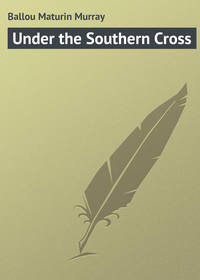 полная версия
полная версияThe New Eldorado. A Summer Journey to Alaska

Maturin Murray Ballou
The New Eldorado / A Summer Journey to Alaska
PREFACE
The Spaniards of old had a proverb signifying that he who would bring home the wealth of the Indies must carry the wealth of the Indies with him. If we would benefit by travel we must take with us an ample store of appreciative intelligence. Nature, like lovely womanhood, only reveals herself to him who humbly and diligently seeks her. As Sir Richard Steele said of a certain noble lady: “To love her is a liberal education.” Keen observation is as necessary to the traveler who would improve by his vocation as are wings to an albatross. The trained and appreciative eye is like the object-glass of the photographic machine, nothing is so seemingly insignificant as to escape it. Careless, half-educated persons are sent upon their travels in order, it is said, that they may “learn.” Such individuals had best first learn to travel. Those who improve the modern facilities for seeing the world acquire an inexhaustible wealth of information, and a delightful mental resort of which nothing can deprive them. The power of vision is thus enlarged, many occurrences which have heretofore proved daily mysteries become clear, prejudices are annihilated, and the judgment broadened. Above all, let us first become familiar with the important features of our own beautiful and widespread land before we seek foreign shores, especially as we have on this continent so much of unequaled grandeur and unique phenomena to satisfy and to attract us. It seems to the undersigned that perhaps this volume will have a tendency to lead the reader to such conclusion, and certainly this is its primary object.
M. M. B.CHAPTER I
Itinerary. – St. Paul. – The Northern Pacific Railroad. – Progress. – Luxurious Traveling. – Riding on a Locomotive. – Night Experiences. – Prairie Scenes. – Immense Grain-Fields. – The Badlands. – Climbing the Rocky Mountains. – Cinnabar. – The Yellowstone Park. – An Accumulation of Wonders. – The Famous Hot Springs Terrace. – How Formed. – As Seen by Moonlight.
A journey from Massachusetts to Alaska was a serious undertaking a few years ago. It involved great personal risk, considerable expense, and many long months of weary travel; but it is now considered scarcely more than a holiday excursion, a good share of which may be denominated a marine picnic. That an important country, so easily accessible, should remain comparatively unexplored seems singular in the nineteenth century, especially when its great mineral wealth and natural attractions are freely admitted. The trip to Sitka, the capital of the Territory, and back is easily accomplished in three months, affording also ample time to visit the principal points of interest on the route, including the marvels of the Yellowstone National Park, in Wyoming, which is not only not surpassed in grandeur and beauty by any scenery on the continent, but in fact has no parallel on the globe. The traveler also naturally pauses on his way to examine at least one of the great mining centres of this gold-producing country, such as Butte, the “Silver City” of Montana, where he may behold scenes eclipsing in affluence the fabulous story of Midas. The plan adopted by the author, as herein detailed, was to make the westward journey by the Northern Pacific Railroad to Tacoma, on Puget Sound, where the remarkable inland sea voyage begins, thence sailing north to Pyramid Harbor and Glacier Bay, stopping as usual at the intermediate places of interest.
On the homeward passage, to vary the journey and to enjoy the wild scenery of British Columbia, Alberta, Assiniboia, and Manitoba, he left the steamer at Vancouver, returning by the Canadian Pacific Railway, which presents to the lover of nature such famous scenic advantages.
The journey westward seems practically to begin when the traveler reaches St. Paul, the capital of Minnesota, by way of Chicago, as here he strikes the trunk line of the Northern Pacific Railroad, which has an exclusive and unbroken track thence to Tacoma, a distance of nearly two thousand miles, the whole of which is covered with novelty and interest.
We will not pause to fully describe St. Paul, that youthful city of marvelous growth, promise, and beauty, with her mammoth business edifices of stone and brick, her palatial private residences, and her charming boulevards. The most casual visitor is eloquent upon these themes, as well as regarding the open-handed hospitality of her two hundred thousand inhabitants. Three iron bridges span the Mississippi at St. Paul, one of which is nearly three thousand feet long, supported upon arches two hundred and fifty feet in span, and having a roadway elevated two hundred feet above the water.
St. Paul is situated upon a series of terraces rising from the left bank of the Mississippi River, its site being both commanding and picturesque. Thus built at the head of navigation on a great waterway, it naturally commands a trade of no circumscribed character, besides enjoying the prestige of being the State capital.
Were it not for the unlimited facilities of transportation afforded by the grand and beneficent railroad enterprise embraced in the Northern Pacific system, the development of the vast and fertile country which lies between Lake Superior and the Pacific Ocean would have been delayed for half a century or more. It should be remembered that so late as 1850 there was not one mile of railroad in existence west of the Mississippi River. In 1836 there were, at most, but a thousand miles in operation on the entire American continent. This is an epoch of progress. Japan is traversed by railways, even China has caught the contagion, and is now building roads for the use of the iron horse in more than one direction within that ancient and widespread empire, while Russia and India are “gridironed” with rails.
It was remarked in a congressional speech in the year 1847 that the Rocky Mountains would be the limit of railroad enterprise across our continent; that the barrier presented by these huge elevations and the extensive “desert tract” beyond them must certainly prevent the development of the Pacific States.
“Desert,” indeed!
No land on the globe produces such remarkable cereal crops as this very prairie soil is doing each successive year, not only supplying our own rapidly increasing population with the stuff of life, but also feeding the less fortunate millions of Europe, where excessive labor and costly enrichment must make up the deficit arising from an exhausted soil and circumscribed area. The reader who follows these pages will not fail to see how liable legislators are to be mistaken in their predictions, and how apt events are to transcend the weak judgment of the confident and inexperienced declaimer. Even that Titan statesman, Daniel Webster, put himself on record in the United States Senate, while speaking against a proposition to establish a mail route through a portion of the western country, as follows: “What do we want with this vast, worthless area – this region of savages and wild beasts, of deserts of shifting sands and whirlwinds of dust, of cactus and prairie dogs? To what use could we ever hope to put these great deserts or those endless mountain ranges, impenetrable, and covered to their very base with eternal snow? What can we ever hope to do with the western coast, – a coast of three thousand miles, rock-bound, cheerless, uninviting, and not a harbor on it? What use have we for this country?”
In crossing the continent by the route we have chosen, one passes through a country whose grand scenic charms can hardly be exaggerated, in describing which superlatives only will apply, and whose agricultural advantages, natural resources, and mineral wealth are probably unequaled in the known world. We are taken through the productive wheat-fields of Minnesota and Dakota, among the gold and silver bearing hills of Idaho and Montana, into the prolific, garden-like valleys of Washington, whose lovely hopfields rival the gorgeous display of Kent in England, and whose abundant supply of coal and iron is only second to that of Pennsylvania.
The State has been, and may well be, denominated the Eden of the North Pacific.
On our way we are constantly meeting immense freight trains, laden with grain, flour, cattle, and other merchandise, bound for the Atlantic coast; long strings of coal cars, winding snake-like round sharp curves, and creeping up steep grades; passenger vans crowded with animated, intelligent people, all together testifying to the great and growing traffic of the West and Northwest. We pass scores of lofty grain elevators, high piles of lumber, and miles of various kinds of merchandise prepared for, and awaiting, shipment eastward, all of which evinces a local capacity for production far beyond our computation. How marvelous is the change from the conditions existing in this region a few years since, when millions of buffaloes roamed unmolested over these plains, valleys, and hills from Texas to Manitoba! The skeletons of these herds still sprinkle the prairies, bleached by the summer sun and crumbled by the winter’s frost. Hundreds of carloads are annually shipped eastward to the factories which manufacture fertilizers.
As we speed on our western journey day and night, gliding through long tunnels and deep rock cuttings, over airy trestles, immense embankments, bridges, and viaducts, representing the skillful accomplishments of modern engineering, we carry along with us the domestic conveniences of home. The train, in fact, becomes our hotel for the time being, where we bathe, eat, sleep, and enjoy the passing scenery seated in luxuriously upholstered easy-chairs, which at night are ingeniously transformed as if by magic into soft and inviting beds. The elegance and comfort of these parlor, dining, and sleeping cars is calculated to make traveling what it has in a measure become, an inviting luxury. The miraculous cap of Fortunatus would seem to have been pressed into our service. So thoroughly perfected is the transcontinental railroad system that it is quite possible to enter the cars in an Atlantic city, say at Boston or New York, and not leave the train until five or six days have expired, when the objective point on the Pacific coast is reached.
While passing through deep gorges at night, or creeping over a mountain top, the effect from one’s seat in the cars is weird and curious, especially when the winding track makes long curves in the train, so that the panting iron horse is seen from the rear, all ablaze and emitting dense clouds of smoke. The snow-tipped peaks on one side and the threatening gulch of unknown depth on the other assume a mantle of soft, gauze-like texture in the clear moonlight. At times one half believes this rails are laid upon the tree-tops, the branches of which loom up so close to us. Away in the valley, two thousand feet and more below our level, a rippling stream sparkles in the silvery light while on its way to swell some larger watercourse which drains the rocky hills. Looking far across the valley we try to make out the distant mountains, but only dim phantoms of gigantic size are seen, gliding stealthily away in the darkness.
We make interest with the conductor and engineer of the train for a special purpose. We are in search of a new sensation, to wit, such as may be derived from a night-ride on the engine, where one can see all the engineer sees, which is indeed little enough. The headlight of the locomotive throws its rays dimly on the darkness for a few rods in advance of the train. But what does that amount to, so far as being able to avoid danger? That brief space is passed in a second of time, and it is impossible to see what is beyond. The faithful engineer stands with both hands upon the machinery, one with which to instantly apply the brakes, the other to shut off the steam if danger shows itself ahead. That is all he can do. What a boisterous, asthmatic monster it is that drags the long train through the darkness at the rate of a mile in two minutes! How its hot breath belches forth, and how it springs and leaps over the iron track, fed incessantly with fresh fuel by the stoker! To one not accustomed to the oscillating motion, it is nearly impossible to keep his footing, much more difficult than on board of a pitching or rolling ship at sea. The motion is short, quick, and incessant. Black, – black as Erebus; how venturesome it seems to dash into such darkness! What a tempting of fate! Yet how few accidents, comparatively, occur! “The law of averages is what we calculate upon,” said the engineer of No. – ; “about so many people will be killed annually out of a given number of railroad travelers. We take all reasonable precautions to prevent accidents, but there are thousands of exigencies beyond our control.” If any one proposes to you, gentle reader, to indulge in a night-ride on a locomotive, take our advice, and don’t do it.
One does not linger in bed when passing through a country famous for its scenery. The experienced traveler has learned that the opening hours of the day are those in which his best and clearest impressions are received. He therefore rises betimes to enjoy the cool, dewy freshness of the morning. Now and again a prairie-owl is seen groping its winged way to shelter from the increasing light. He is sure to see plenty of coyotes, gray wolves, and graceful antelopes on the rolling prairies, each of these animals exhibiting in some special and interesting manner its natural proclivities. The prairie-dog nervously diving into and leaping out of its little prairie mound; the wolf bravely facing and glaring at the passing train, though careful to keep at a wholesome distance; and the antelopes in small herds hastening away by graceful bounds over the nearest hills, far too pretty and far too ornamental to shoot, suggesting in form and movements that most picturesque of wild animals, the Tyrolean chamois.
Minnesota presents to the eye of the traveler a grand and impressive country in the form of rolling prairies, diversified by lakes, – of which there are said to be ten thousand in the State, – forests, and inviting valleys, the latter particularly adapted for raising wheat and for dairy farming. Vast fields of ripening cereals are seen stretching for miles on either side of the railroad, without a fence to break their uniformity. This State possesses among other advantages that of a climate particularly dry, invigorating, and healthful. Four hundred miles of our route is through Northern Dakota, where the farming lands are easily tilled, well watered, and wonderfully prolific in crops. The choicest wheat grown in America, known as hard spring wheat, comes from this section, which has been called “the granary of the world.” The gigantic scale on which wheat-raising is here conducted would seem incredible if faithfully described to an old-time New England farmer. The improvement which has been made in machinery connected with sowing, reaping, harvesting, and threshing grain enables one man to do as much in this western country as a dozen men could accomplish twenty-five or thirty years ago. There are wheat farms here embracing twenty thousand acres each, where economy in labor is of the utmost importance, and where the employees are so numerous as to be kept under semi-military organization. The author has seen the big grain-fields of Russian Poland in their prime, but they are as nothing when compared with those of Northern Dakota, nor are the farming facilities which are generally employed throughout Europe nearly equal to those of this country.
At Bismarck, capital of the State, which is a small but energetic and thriving place, the Missouri River is crossed by a magnificent iron bridge, hung high in air, which cost a million dollars. This is the acme of successful engineering, passing our long, heavy train of cars over a track of gleaming rails from shore to shore without the least perceptible tremor, or the deflection of a single inch. The great waterway which it spans measures at this place fully twenty-eight hundred feet from bank to bank, though it is at this point two thousand miles from its confluence with the Mississippi.
The route we are following soon takes us through what are called the Badlands, a most singular region, where subterranean and surface fires are constantly burning, where trees have become petrified, and where the natural blue clay has been converted into terra cotta. This locality, extending for miles and miles, has been called Pyramid Park, on account of its fantastic forms presented in a singular variety of colors, and because of its mounds, domes, pyramids, and rocky towers. These vary as much in height as in form, some measuring ten feet, some two hundred, while all are clad in harlequin costume, black, white, blue, green, and yellow. It is called Badlands in contradistinction to the adjoining country, which is so very fertile, but the district is improved as good grazing ground for many thousands of cattle which supply our Atlantic cities with beef. Some of the best breeds of horses furnished to the Eastern States are raised, fed, and brought into marketable condition on these peculiar lands.
This region forms a sort of tangible hint of what we shall experience still farther on our Wonderland journey in the interesting and unequaled valley of the Yellowstone, where there are abundant evidences of volcanic force and subterranean fires, and where Nature is seen in her most erratic mood.
Just as we pass from Dakota into Montana, a short distance beyond the Little Missouri River, a lofty peak called Sentinel Butte is seen, at an elevation of nearly three thousand feet above sea level. The teeming, vigorous young life of the Northwest is manifest all along the route, with its wonderful energy and its almost incredible rate of progress. We were told that in the State which we had just left three thousand miles of railroad had been built and properly equipped before it contained a single town of more than five hundred inhabitants.
In the State of Montana we find a more hilly country than that through which we have so recently passed, yet it is well adapted to farming and possesses large areas of excellent grazing land. Indeed, there is scarcely any part of this territory, except the mountain ranges, where the climate is not sufficiently mild for cattle to winter out-of-doors. Undoubtedly they will thrive better for being housed at night in the coldest weather here or anywhere, but this is not absolutely necessary. No food is required for them except the native bunch grass, which cures itself, and stands as hay until the succeeding spring. Cattle are very fond of and will quickly fatten upon it. Sheep husbandry is also a great and growing interest here. We observe now and again a thrifty flock, tended by a boy-shepherd accompanied by his dog, recalling similar scenes in Tasmania and on the plains of Russia.
Statistics show that there are over two million acres now under cultivation in Montana, and that the territory is also fabulously rich in minerals. The present output of gold, silver, and copper is at the rate of three million dollars per month, and the yield of the mines is steadily on the increase.
As we hasten on our way, looking on one side far down into sombre depths, and on the other at threatening, overhanging bowlders, or backward at the road-bed cut out of the solid rock which forms the cliff, we wonder at the successful audacity which conceived and built such a difficult highway. We have seen few instances of similar engineering so remarkable as is exhibited at certain points on the Northern Pacific Railroad. Equal difficulties have been overcome on the Zig-zag Railway over the Blue Mountain Range, near Sidney, Australia, and also in Northern India, where the narrow gauge railroad climbs the foothills of the Himalayan Range to Darjeeling, about eight thousand feet above the plains of Hindostan, but in neither of these instances is the work so thorough, or on so gigantic a scale, as where the Northern Pacific crosses the Rocky Mountains.
We are quite conscious of being on an up grade, the large engine panting audibly from its extra exertion, and the train moving forward no faster than one could walk. Presently tall, snow-capped peaks come trooping into view, like mounted Bedouins clad in fleecy white, as the small city of Livingston is reached. This locality is about forty-five hundred feet above the sea. The town is situated in a beautiful valley, with nothing to indicate its altitude except the snow-crowned mountains not far away, standing like frigid sentinels. The observant traveler will also notice a certain rarefied condition of the atmosphere. Here we are about midway between the Great Lakes and the Pacific coast, – between Superior, the largest lake on the globe, and the Pacific, the largest ocean in the world.
Livingston contains three thousand inhabitants, and is a thriving place, the frequent resort of many lovers of the rod and gun, both large and small game being found in abundance hereabouts. Forty miles north of Livingston is Castle Mountain mining district, rich in silver ores, and from whose argentiferous soil millions of dollars have been coined and hundreds of enterprising prospectors enriched. A branch road is taken at this point which runs directly southward to Cinnabar, a distance of nearly fifty miles, from which place coaches convey the traveler about six miles farther to the Wonderland of our continent, – the Yellowstone National Park.
The terminus of the railroad is known by the name of Cinnabar because it is situated at the base of a mountain bearing that title, remarkable for its exposure of vertical strata of three distinct geological periods. Here is a famous place known as the Devil’s Slide, a singular formation caused by the washing out of a vertical stratum of soft material between one of quartzite and another of porphyry. The slide is two thousand feet high, and being of different color from the rest of the rocky mountain side is discernible for many miles away.
We have now reached one of the most remarkable points of our excursion, which demands more than a passing notice, sharing with the great glaciers of Alaska the principal interest of the present journey westward across the continent.
This magnificent territorial reservation is situated in the northwestern part of Wyoming, embracing also a narrow strip of southern Montana and southeastern Idaho, lying in the very heart of the Rocky Mountains. It was wisely withdrawn from settlement by an act of Congress in 1872, and is beneficently devoted forever to “the pleasure and enjoyment of the people.” It forms a great preserve for wild animals, and a natural museum of marvels free to all. The well conceived liberality of this purpose is only commensurate with the unequaled grandeur of the Park itself, though at the time of passing this law comparatively little was actually known of the stupendous marvels contained within its widespread borders, besides which fresh discoveries of interest are still being made annually.
Of all those who have endeavored to depict this locality, none have been able to convey with the pen an adequate idea of its wild magnificence, or to give a satisfactory description of its accumulated wonders. The eye alone can appreciate its indescribable beauty, majesty, and loveliness.
By the judicious expenditure of public money and the liberal outlay of corporate enterprise in road and bridge building, not to mention other facilities, one can now pretty thoroughly explore the Park in the brief period of a week or ten days. To do this satisfactorily heretofore required thrice this length of time, besides which, camping out was necessary; but it is no longer so, unless one chooses to play the gypsy. This plan is adopted by a few summer tourists, who take with them a regular camp outfit, depending upon the fish they catch for a considerable portion of their food supply during this out-of-door life.
The Park is under the control of the Secretary of the Interior. A local superintendent lives here, who is assisted by a few game-keepers and government police, besides which there is a small gang of laborers constantly at work during the favorable season, building roads and bridges, opening vistas here and there, and clearing convenient footpaths, under the direction of an army engineer. Two companies of United States cavalry make their headquarters in the Park during the summer months, distributed so as to prevent any unlawful acts of visitors. The size of the reservation is sixty-four miles in length by fifty-four in width, thus giving it an area of over three thousand six hundred square miles. Or, to convey perhaps a clearer idea of its extent to the reader’s mind, it may be said to be nearly one half the size of the State of Massachusetts. It is a volcanic region of incessant activity, with mountains ranging from eight to twelve thousand feet in height, and embracing a collection of spouting geysers, hot springs, steam holes, petrified forests, cascades, extraordinary cañons, and grand waterfalls, such as are unequaled in the known world.









